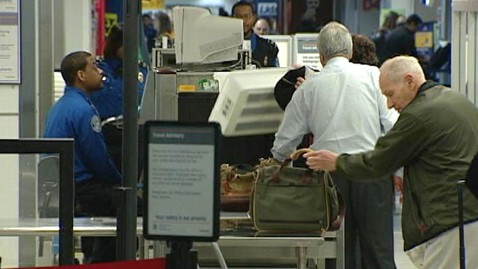Snow Globes Out, Small Scissors In: Current Airport Screening Rules

(Image Credit: ABC News)
Do I need to take off my flimsy straw sandals even if I know they don't have metal in them? Wait - you can bring scissors onboard now? What's the 4-1-1 on 3-1-1?
Confusion can blur people's understanding of airport screening rules. It's no wonder: The rules change. The Transportation Security Administration, founded after 9/11 to keep us safe without unduly blocking our cherished mobility, designs, enforces and refines policies using evolving technologies and tools against an evolving terrorist threat.
You've heard of the shoe bomber and underwear bomber. "The No. 1 threat is nonmetallic improvised explosive devices concealed on a passenger's body," said Greg Soule, a TSA public affairs officer. Here are some highlights of the current rules intended to limit that and other threats.
Liquids, Gels and Aerosols - On August 10, 2006, British police foiled a plot to use liquid explosives to blow up at least 10 airplanes traveling from the U.K. to North America. Travelers' ability to carry liquids, gels and aerosols onto their flights vanished "virtually overnight," Soule said. TSA loosened the new rules a few weeks later.
You can carry on small amounts of liquids, but you must follow what TSA calls the 3-1-1 rule: 3.4-ounce container(s) or smaller, in one quart-size clear plastic zip-top bag, one bag per passenger. Medications, baby formula and food, and breast milk are allowed in reasonable quantities exceeding 3.4 ounces, and don't have to be in the bag. Declare these things at the checkpoint. Officers may open some or all of them to screen them.
The 3.4 ounces applies to the container. Larger containers that are partly filled and large toothpaste tubes that are rolled up aren't allowed. What's a "liquid"? Use this informal rule of thumb: If you can pour, pump, squeeze, spread, smear, spray and/or spill it, it's a liquid. Pastes, ointments and mascara are considered liquids.
Frozen food is considered a solid. If it's partially melted - "such as gravy," TSA's website says - it's liquid, and subject to 3-1-1.
Gel shoe inserts are forbidden onboard aircraft. Gel-filled bras are allowed.
Snow globes and other tchotchkes containing liquid are prohibited, "even with documentation."
Shoes - Soule said TSA originally required all shoes be removed before entering the walk-through metal detector, then only some types, then, around 2006, it went back to all shoes. Children 12 and younger may now keep their shoes on. As with all TSA rules, the reason for the rule and the changes is current intelligence, Soule said. "We know certain individuals are looking for creative concealment [of potential weapons]," he said.
ID - If experience has left you braced for many officials asking you for your ID and/or boarding pass, you can relax (for now). Although in the past, at some airports, adults 18 and over have been asked to present them at multiple times and places, now you can expect to show both documents once and then put them away, Soule said. Children are not required to show ID, but all passengers on international flights, including children, need a passport.
Clothing - There are no restrictions, but TSA does suggest you remove metal on your body - jewelry, cufflinks, belt buckles - to speed up screening. Transportation Security Officers (TSOs) must identify any metal detected at the checkpoint using hand-wand and/or pat-down inspection.
Sharp Objects - The 9/11 hijackers used box cutters to overpower airline crew and take control of the planes, and sharp objects are still prohibited. However, scissors with blades shorter than four inches, even with pointed tips, are now allowed.
Most sporting goods - bats, bows, sticks, cues, golf clubs - are prohibited for the same reason. Ice skates - despite having potentially long, sharp blades - are allowed.
Most tools are prohibited (hatchets, hammers, drills/bits, etc.). Screwdrivers seven inches long or shorter are allowed, perhaps surprisingly, as are wrenches and pliers seven inches long or shorter.
Firearms and Combustibles, understandably, are prohibited (this includes bb and pellet guns). TSA confiscated more than 1,300 firearms last year, Soule said. Most are allowed to be checked, the exceptions being flares and gun powder. Common lighters are O.K., as is one book of safety (non-strike anywhere) matches.
Passing through electronic detection equipment is optional, though TSA assures it is safe for all, including pregnant women. Those opting out will be searched via pat-down.
TSOs have discretion to prohibit any item they think poses a security threat.
Watch the full story on TSA's evolving tactics against air-travel terrorism on "20/20? Friday at 10 p.m. ET